The porcelain laminate veneer is a conservative alternative to full coverage restorations in the anterior region in most of the situations. The retention of porcelain laminate on the tooth surface depends on the luting agent. It is desirable that ceramic restorations are strongly bonded to cavity preparations and abutment teeth with a resin-based luting agent. The tooth preparation design of the porcelain laminate is such that most of the margins are exposed to the oral environment. This causes marginal leakage and dissolution of the luting agent. Therefore selection of proper luting agent for the cementation of the porcelain laminate is a very important step [1]. A high-quality adhesion of the resin cement to the tooth structure and restoration surface is primordial for the success of bonding [2]. Akin H, Z Ozkurt, O Kırmalı, E Kazazoglu and AK Ozdemir evaluated different surface treatment methods to improve shear bond strength values. They found that lazer treatments produce better results [3]. Various glazing agents are advocated to increase in the shear bond strength a methacrylate resin based cement and an yttria-stabilized zirconia dental ceramic substrate. It has been proved that application of resin-based luting and priming agents containing the adhesive monomer MDP provide better bond strength to zirconia than do other systems [4]. Tabassom Hooshmand et al., concluded that the interfacial fracture toughness for the lithium disilicate glass ceramic system was affected by the surface treatment and the type of luting agent [5].
This study was undertaken to determine the adhesive bonding characteristics of five dual cured resin luting agents used for cementation of porcelain laminate veneers prepared with lithium disilicate based ceramic material i.e. IPS Empress II E-Max Press.
Materials and Methods
The study was carried out at VSPM Dental College and research centre, Nagpur. The approval was obtained from Institutional Ethics committee. The duration of the study was six months. The exclusion criteria was-
Carious teeth.
Fracture of the coronal structure.
Root canal treated teeth.
Teeth with the restorations and hypoplastic defects.
Eighty sound, freshly extracted maxillary and mandibular premolars were selected for the study. The teeth were examined for caries, restorations and hypo plastic defects and then selected for this study. Any calculus deposits and soft tissues were removed with periodontal scaler. All the samples were stored in distilled water after extraction for 48 hours. The teeth were divided at random into five equal groups designated as A,B,C,D,E for the luting agents.
GROUP A- RelyX ARC
GROUP B- Panavia F2.0
GROUP C- Variolink II
GROUP D- Duolink
GROUP E - Nexus NX3
A rectangular stainless steel block of dimension 30mm ×10 mm×25 mm was prepared. A metal plate of 30mm×15mm×2mm dimensions with a circular opening of 4mm diameter in the center was prepared. This plate fits exactly on the top of the stainless steel block [Table/Fig-1].
Metal mold for die preparation
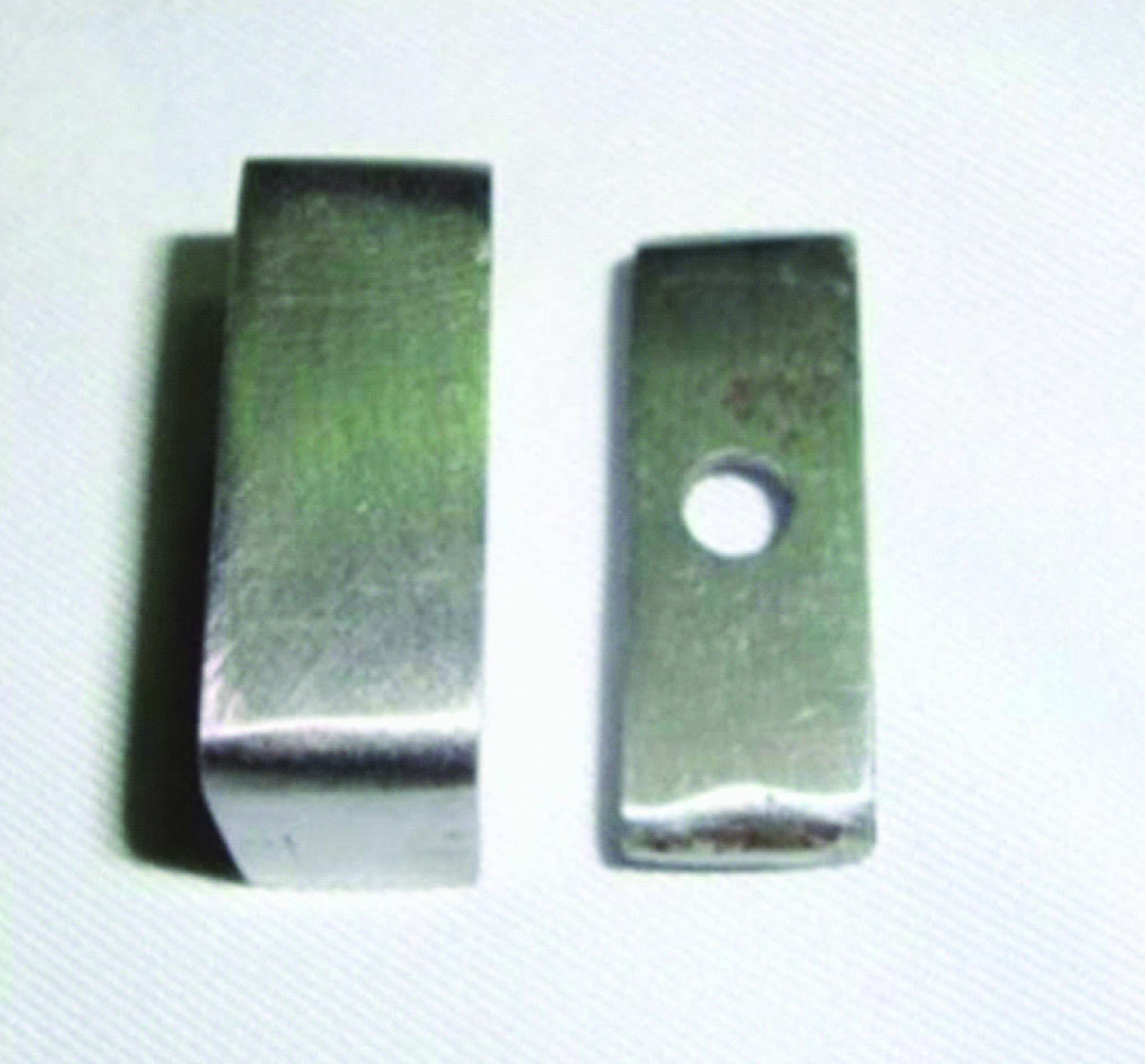
The special tray was prepared for making an impression of stainless steel block in self cured acrylic resin (DPI,). The impression of block was made with polyether impression material (Impregum 3 m ESPE). The impression was poured in type IV improved stone (Kalrock).
The central portion of 2 mm width was marked on the stone block. In this region the die spacer (TRU-FIT, GEO TAUB) was painted in two coats [6]. This simulated the clinical conditions. After the die spacer was dried, the plate with circular opening was oriented on the die stone block. Wax patterns of the laminates were prepared by flowing pattern wax (Bego) in the circular opening. The circular wax patterns were sprued with the help of spruce wax (Mark) of diameter 3mm. Then the entire assembly was invested in the phosphate bonded refractory investment material (Press Vest Ivoclar Vivadent,). The invested ring was kept aside undisturbed for three hours for complete setting and then it was kept in preheating furnace (Fire Serio) .The porcelain ingots (E-max press, Ivoclar Vivadent,) were placed in the investment ring. The plunger was kept in its predetermined position in the investment ring .The assembly was carried to the E- max press furnace (AP 600 Ivoclar Vivadent). It was set according to manufacturer’s instructions. After cooling, the ceramic disks were recovered. Sandblasting was carried out in the sandblaster (Tissidental). Then finishing and polishing was carried out. Eighty ceramic disks were prepared by above mentioned methods.
A stainless steel metal block of dimension 25 mm ×20 mm × 25 mm was prepared. A rectangular depression of dimension 10 mm × 5 mm ×25 mm was made in this block. These dimensions were suitable for the universal testing machine which would later be used during shear bond testing procedure. A half rounded notch of 5mm× 3 mm ×10mm. dimensions was prepared in the center on one side of the rectangular depression. This notch was prepared to support the luted laminate during shear bond testing procedure. This mold was made in two sections. The two sections were assembled together by machined hole and a stud on the opposing surfaces [Table/Fig-2].
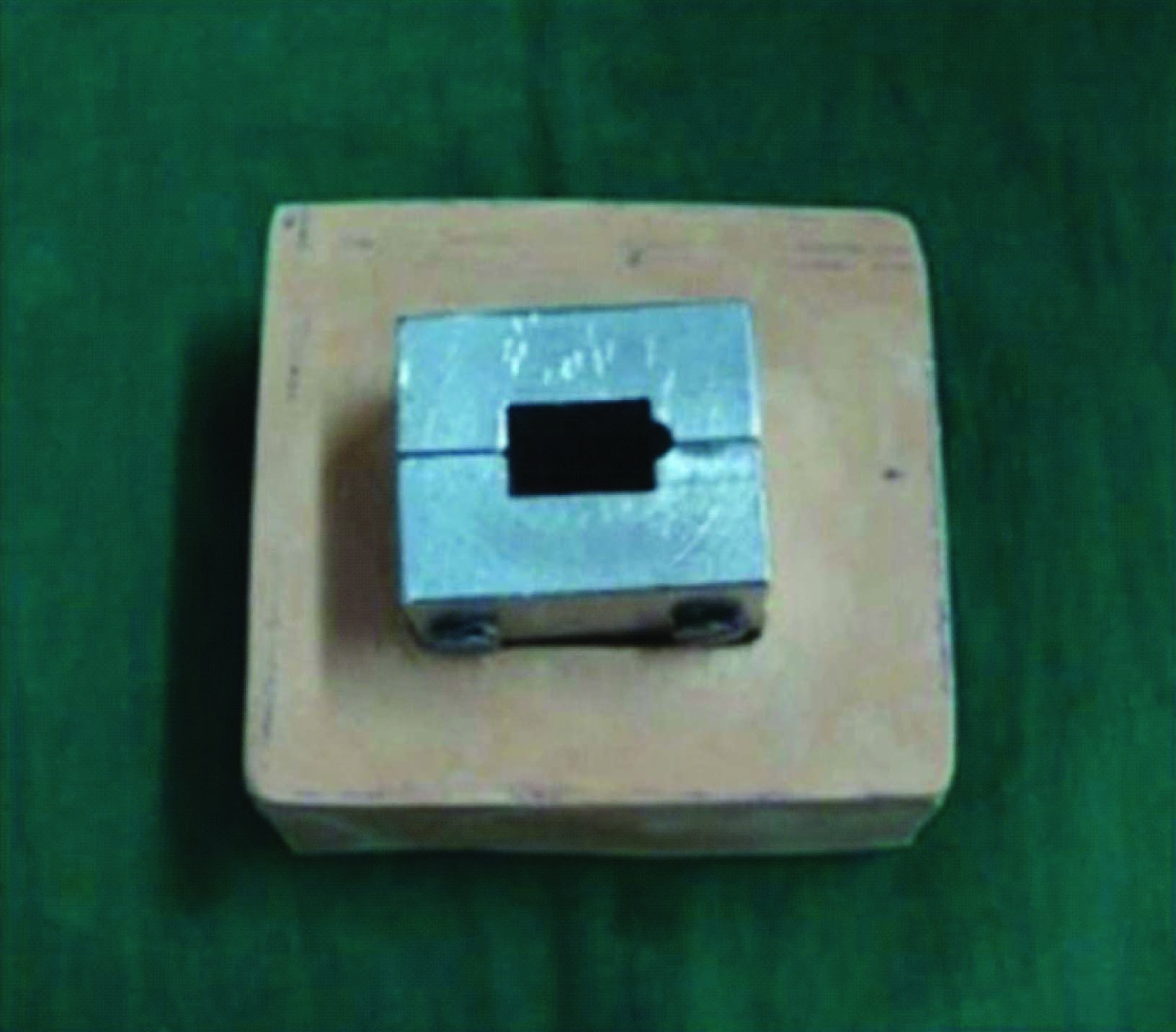
An extracted premolar was kept outside distilled water for an hour before mounting. The portion of the tooth above cemento-enamel junction was exposed. The long axis of the tooth was kept parallel to the vertical axis.
The prepared porcelain disks representing the laminates were etched with 9.6% hydrofluoric acid (Pulpdent corporation) for one minute, washed for 15 sec with three way syringe and dried for 15 sec with air syringe. The silane (Ultradent) was applied with the help of applicator tip in a single coat and kept undisturbed for one minute.
Mounted samples were kept out of water for one hour before the preparation. The buccal surface of the mounted premolar was made flat with the help of diamond wheel (No.WR13). The sample was examined under stereo- microscope (3D Medical systems)with (x 40) magnification to exclude any teeth with exposed dentin. The prepared surfaces of the premolars were treated with 37% phosphoric acid (Prime dent) for 15 sec, thoroughly rinsed and dried as per manufactures instructions.
To minimize the incompatibility between the luting agent and adhesive, the adhesive system recommended by the same manufacturer was used in this study. The luting agent and bonding agent combinations used were-
GROUP A- RelyX ARC and Single Bond (3M,)
GROUP B- Panavia F2.0and Panavia F2.0 ED PRIMER II Liquid A and Liquid B (Kuraray)
GROUP C- Variolink II and Exite DSC (Ivoclar Vivadent)
GROUP D- Duolink and One-Step (Bisco)
GROUP E - Nexus NX3 and Optibond (Kerr)
Manufacturer’s instructions were followed for the bonding procedure [Table/Fig-3]. All specimens were kept in the sample holder under 1 KG weight for 30 min [Table/Fig-4].
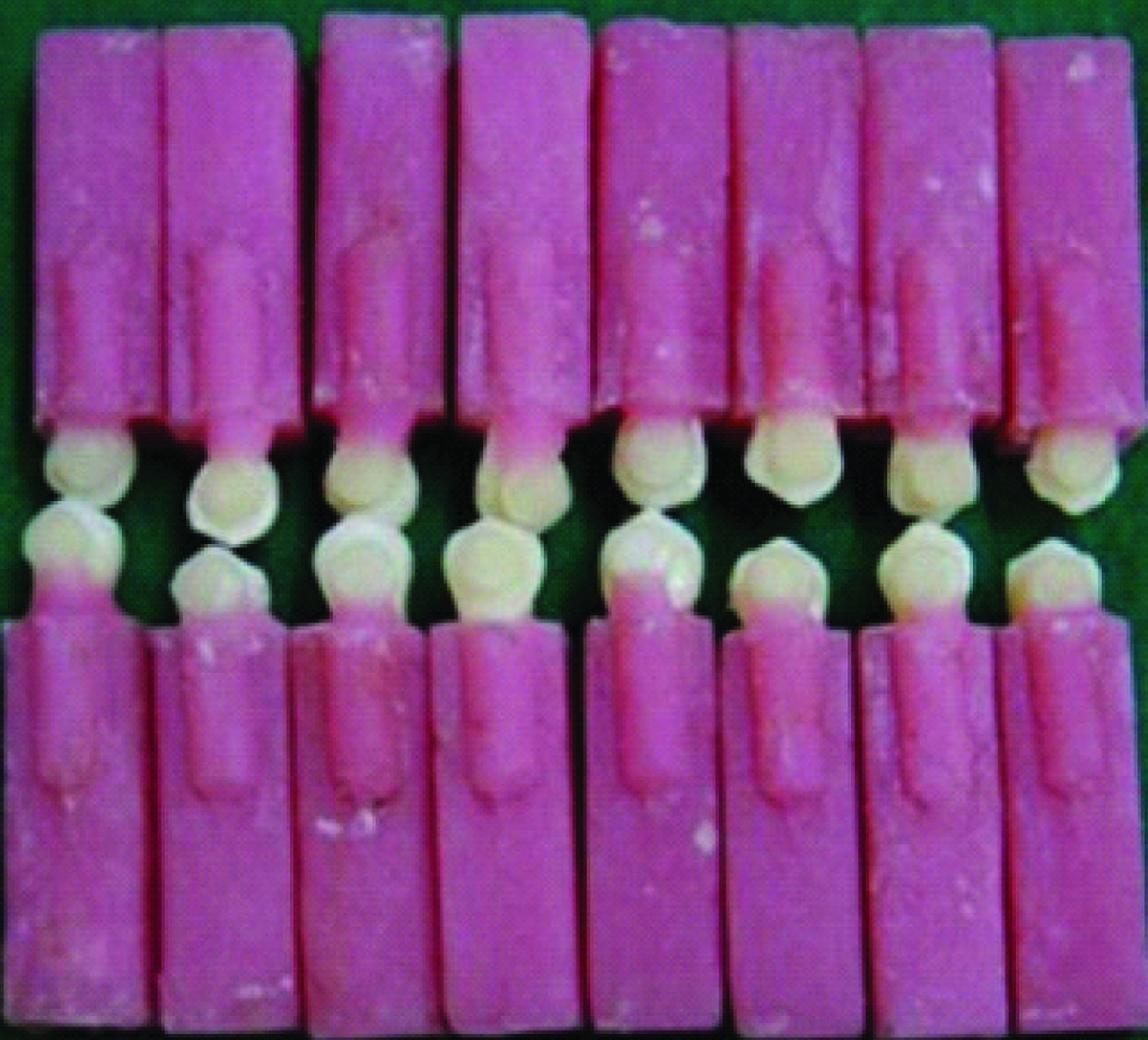
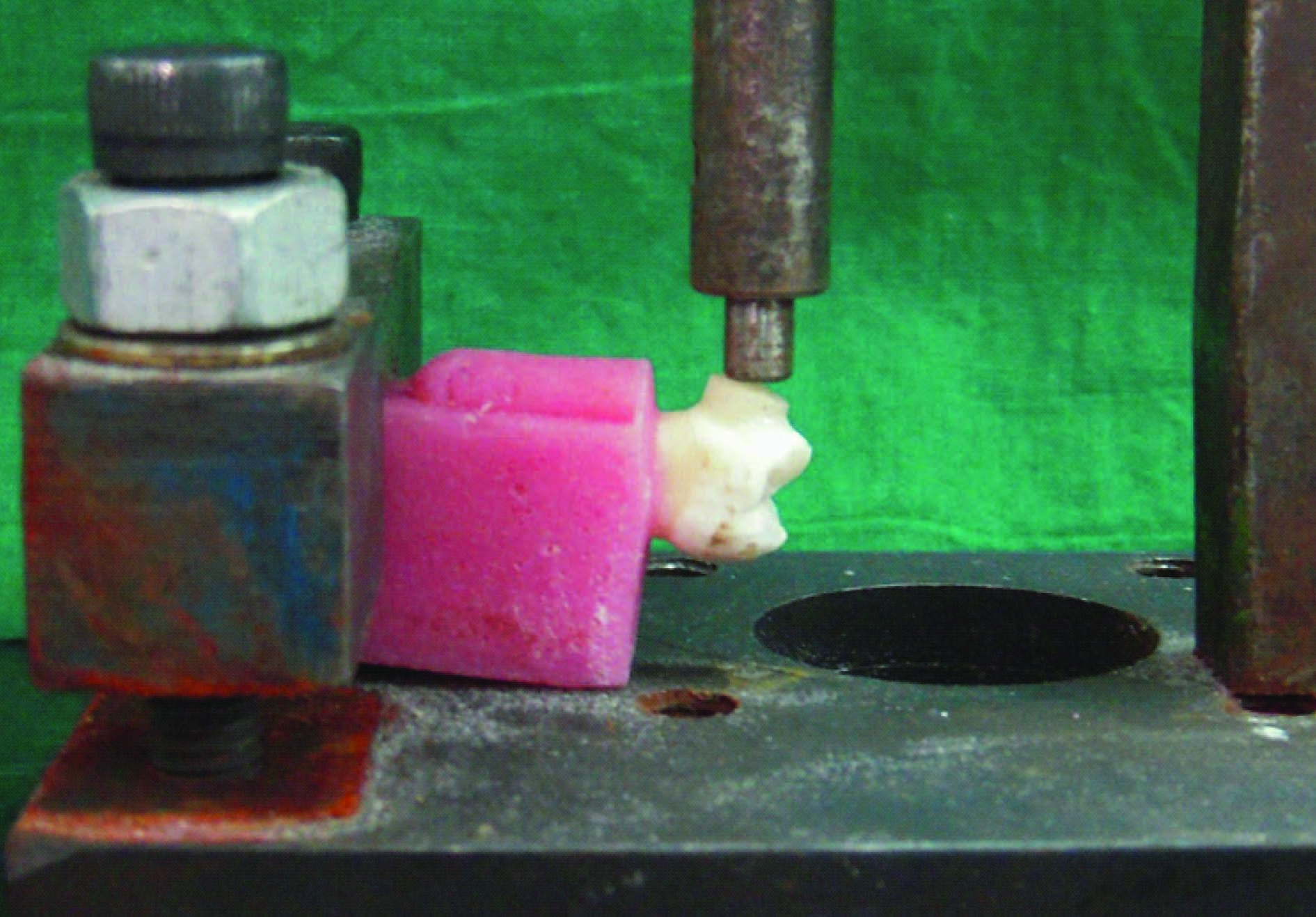
The specimens of all luting agent systems were stored in distilled water for 24 h to simulate the oral environment. The specimens were kept in a thermostatically controlled box till the shear bond testing procedures were carried out.
All the specimens were then carried to the Department of Materials for the shear bond testing procedures. The shear bond test was carried out with the Universal testing machine (Instron U.S.A.) [Table/Fig-5]. The chisel was fabricated for the force application on the specimen during the shear bond testing procedure. The dimensions of the chisel were compatible with the Universal testing machine. The specimens were loaded axially in the universal testing machine. The screw crosshead speed was kept 2 mm/ min until debonding at the laminate - luting agent interface. The maximum load at the debonding was measured. The shear bond strength was calculated in Mpa by dividing this value by the area of the disks for each specimen [Table/Fig-6]. One sample from each group of luting agents was selected randomly for scanning electron microscopic analysis (JEOL).
Universal testing machine
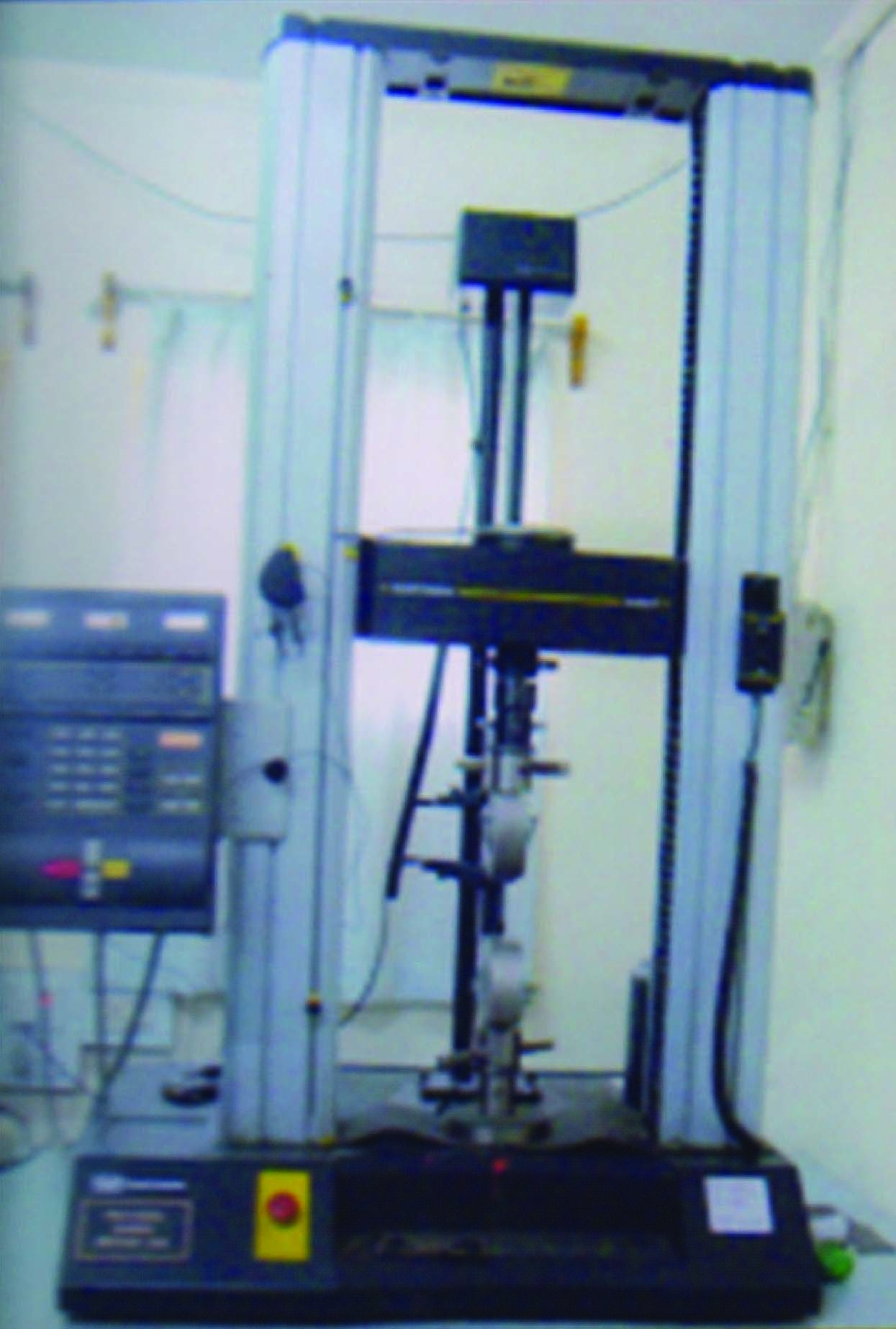
Shear bond Strength of five resin Luting Agent systems
| Group A | Group B | Group C | Group D | Group E |
|---|
| 1 | 10.5096 | 19.2675 | 8.4395 | 24.0446 | 31.8471 |
| 2 | 10.0318 | 21.258 | 7.3248 | 27.3885 | 30.1752 |
| 3 | 11.3854 | 19.1879 | 7.9618 | 27.3885 | 32.1656 |
| 4 | 11.3854 | 20.621 | 7.9618 | 24.0446 | 30.0955 |
| 5 | 10.0318 | 20.0446 | 8.4395 | 27.3885 | 33.121 |
| 6 | 10.5096 | 20.4618 | 8.4395 | 27.4682 | 32.1656 |
| 7 | 15.1274 | 20.6115 | 8.4395 | 27.3885 | 30.1752 |
| 8 | 15.1274 | 20.6115 | 7.8025 | 27.4682 | 33.121 |
| 9 | 11.3854 | 20.6115 | 7.9618 | 27.4682 | 32.1656 |
| 10 | 12.2345 | 21.258 | 8.4395 | 24.0446 | 30.0955 |
| 11 | 10.5096 | 21.258 | 7.9618 | 24.8324 | 33.121 |
| 12 | 12.2345 | 20.621 | 7.3248 | 24.8324 | 30.1752 |
| 13 | 15.1274 | 21.258 | 7.3248 | 27.4682 | 33.121 |
| 14 | 11.3854 | 19.1879 | 7.9618 | 24.0446 | 30.1752 |
| 15 | 12.2345 | 19.2675 | 7.3248 | 27.3885 | 32.1656 |
| 16 | 10.5096 | 19.2675 | 7.3248 | 27.4682 | 32.1656 |
Results
GROUP A- (RelyX ARC) The shear bond strength value of this group ranged from 10.0318 Mpa to 15.1274 Mpa with the mean11.85 Mpa.
GROUP B- ( Panavia F) The shear bond strength value of this group ranged from 19.1879 Mpa to 21.258 Mpa with the mean 20.29 Mpa.
GROUP C- (Variolink II) The shear bond strength value of this group ranged from 7.3248 Mpa to 8.4395 Mpa with the mean 7.90 Mpa.
GROUP D- ( Duolink )The shear bond strength value of this group ranged from 24.0446 Mpa to 27.4682 Mpa with mean 26.26 Mpa.
GROUP E – ( Nexus) The shear bond strength value of this group ranged from 30.0955 M pa to 33.121 Mpa with mean 31.62 Mpa.
The statistical analysis was performed using appropriate tests .The data was interpreted at a confidence interval of 95%. Analysis of Variance test (ANOVA) was used to compare the shear bond strength values of five resin luting agents used in this study. The results of ANOVA test are shown in [Table/Fig-7]. The p-value was 0.005. This analysis revealed that the results were statistically significant. The comparison between the mean, lower class limit( lcl) and upper class limit( ucl) was calculated [Table/Fig-8]. The comparison between the mean shear bond strength of all the groups is done by Scheffe’s multiple –comparison test. The highest mean shear bond strength value was shown in Group E followed by Group B, Group D, Group A. The lowest mean value of shear bond strength was shown by Group C [Table/Fig-9] The mode of fractures occurred at different interfaces was observed under stereomicroscope [Table/Fig-10]. Chi-square test was applied to statistically evaluate the mode of fractures. The value was 27.21and the p-value was 0.00002 which was highly significant. When Odd’s ratio was used the results were significant for Group A and Group D (Odd’s ratio-1).It was not significant for the remaining groups where the value was more than 1 [Table/Fig-11]. This analysis explains that Group A and Group D are at less risk of getting fractured whereas the remaining groups are at higher risk. Amongst these Group C is at the highest risk as its shear bond strength value is the lowest between the luting agents tested and Odd’s ratio is 30.33.
Summary for single classification ANOVA of shear bond Strength of Luting agents, *p<0.05= significant ; **p<0.01 Highly Significant; *P>0.05= Not significant
| Source | S.S | d.f. | M.S. | F | p |
|---|
| Total | 6301.7 | 79 | | | |
| Between | 6180.4 | 4 | 1545.1 | 955.1 | 0.005** |
| Within | 121.3 | 75 | 1.62 | | |
Mean + S.D. of Five shear bond Strength values
| Shear Bond Strength | Mean + S.D. | L.C.L. | U.C.L. |
|---|
| Group A | 11.85 + 1.77 | 10.91 | 12.80 |
| Group B | 20.29+ 0.81 | 19.86 | 20.73 |
| Group C | 7.90 + 0.46 | 7.66 | 8.14 |
| Group D | 26.26+ 1.58 | 25.41 | 27.09 |
| Group E | 31.62 + 1.25 | 30.96 | 32.29 |
Scheffe's Multiple-Comparison test
| Group | Count | Mean | Different from Groups |
|---|
| Group_C | 16 | 7.902062 | Group_A, Group_B, Group_D, Group_E |
| Group_A | 16 | 11.85808 | Group_C, Group_B, Group_D, Group_E |
| Group_B | 16 | 20.29958 | Group_C, Group_A, Group_D, Group_E |
| Group_D | 16 | 26.25792 | Group_C, Group_A, Group_B, Group_E |
| Group_E | 16 | 31.62818 | Group_C, Group_A, Group_B,Group_D |
Mode of fracture in luting agents
| Group | Cohesive fracture | Adhesive Fracture |
|---|
| In Luting Agent | In porcelain | In porcelain & luting agent interface | At tooth & luting agent interface |
|---|
| Group A | 2 | 0 | 11 | 3 |
| Group B | 1 | 2 | 11 | 2 |
| Group C | 12 | 1 | 1 | 2 |
| Group D | 1 | 1 | 11 | 3 |
| Group E | 1 | 2 | 12 | 1 |
| Group | Odds Ratio |
|---|
| Group A | 1.00 |
| Group B | 1.62 |
| Group C | 30.33 |
| Group D | 1.00 |
| Group E | 1.62 |
SEM Analysis
The scanning electron microscopic study was performed at the fractured interface of representative samples from each group of luting agents. This analysis was performed because magnification is over a range of up to six orders of magnitude from about 10 to 500,000 times and it is possible to focus the beam to a spot, and not to image the specimen.In the samples examined under scanning electron microscope, resin tag formation of approximate 10 um depth are observed [Table/Fig-12].Cohesive failure in luting agent are shown [Table/Fig-13]. Adhesive failures between enamel and the luting agent [Table/Fig-14] adhesive failure between porcelain and luting agents are observed [Table/Fig-15].
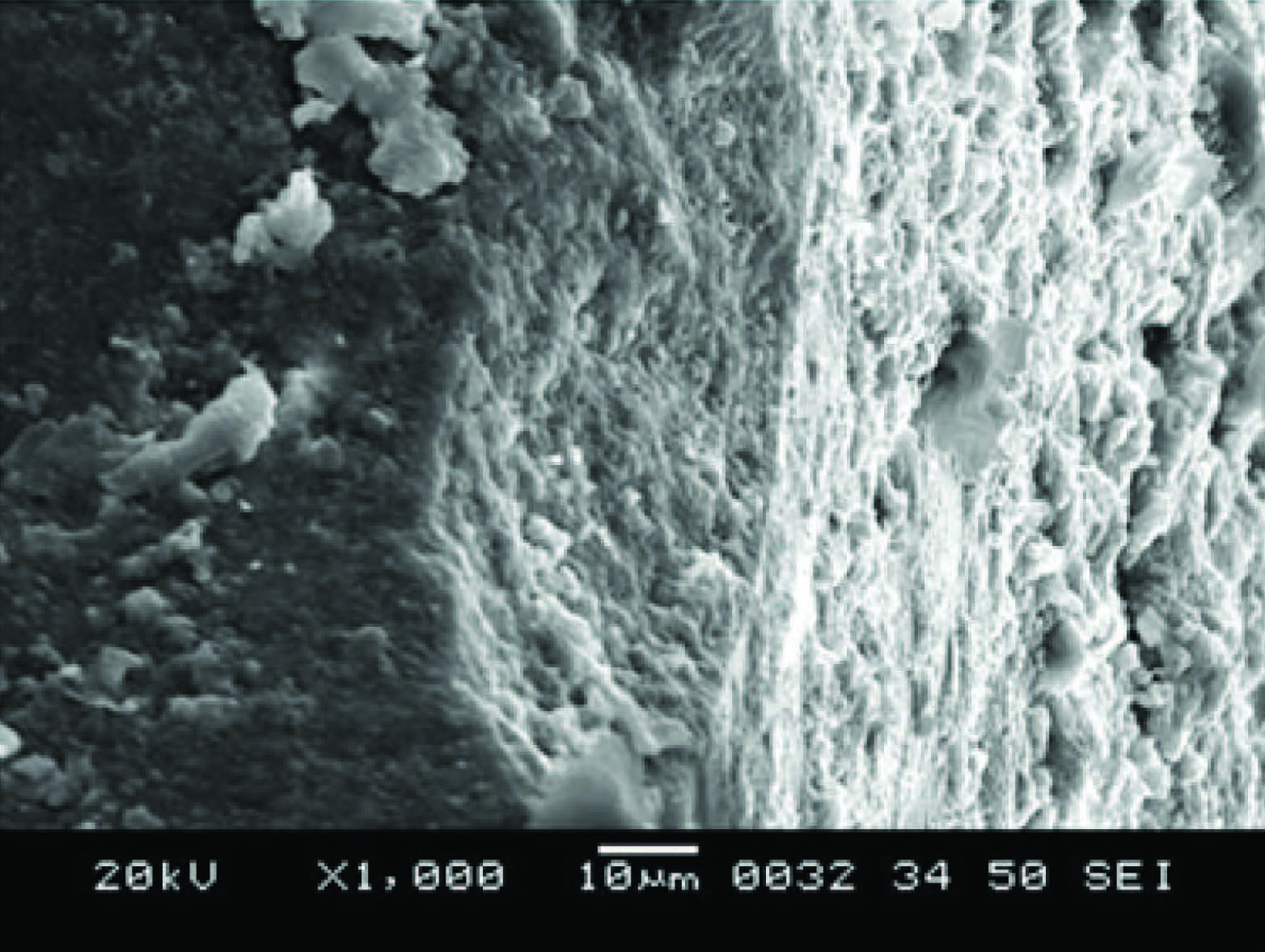
Cohesive fracture in luting agent
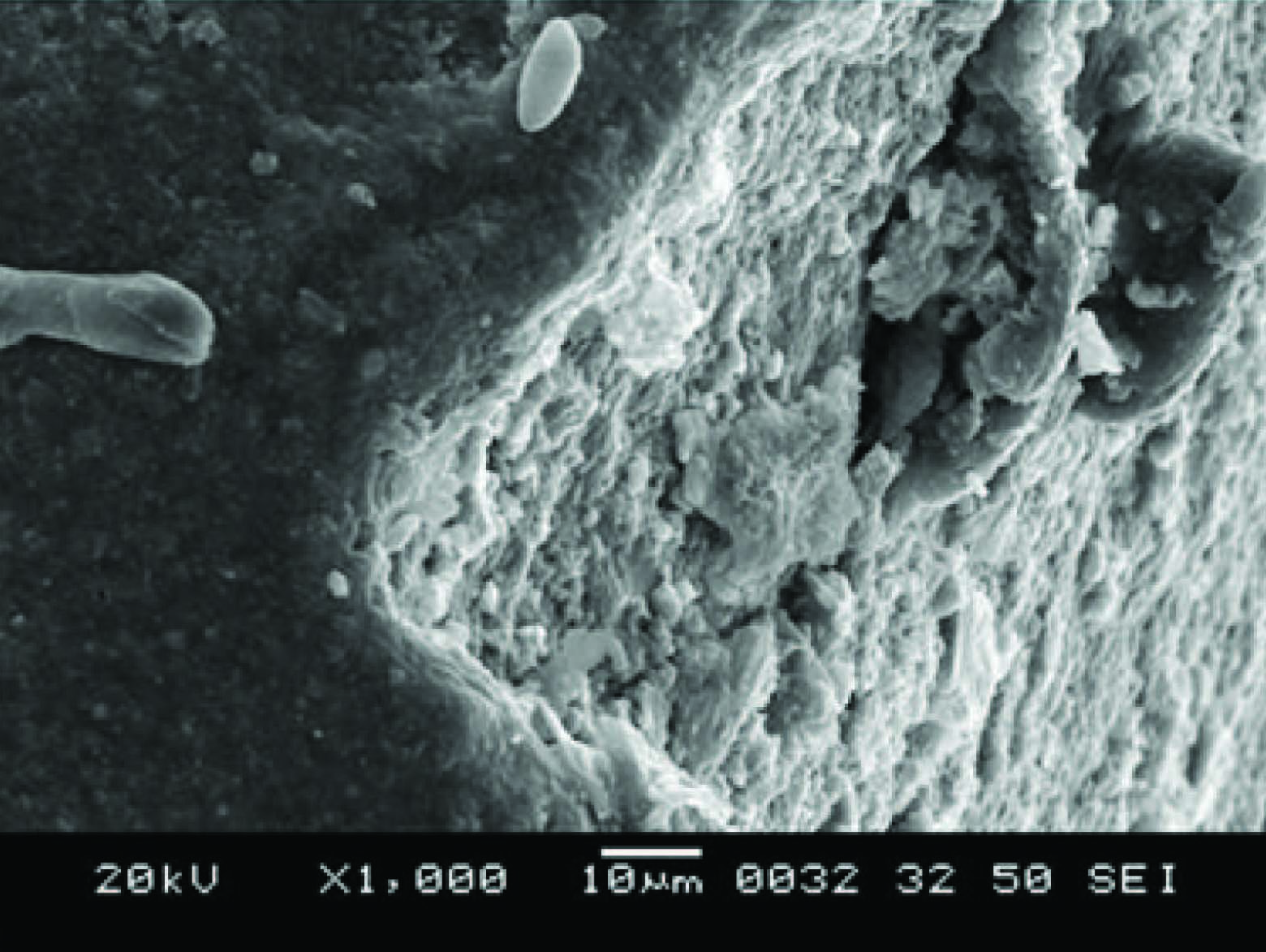
Adhesive fracture between enamel and luting
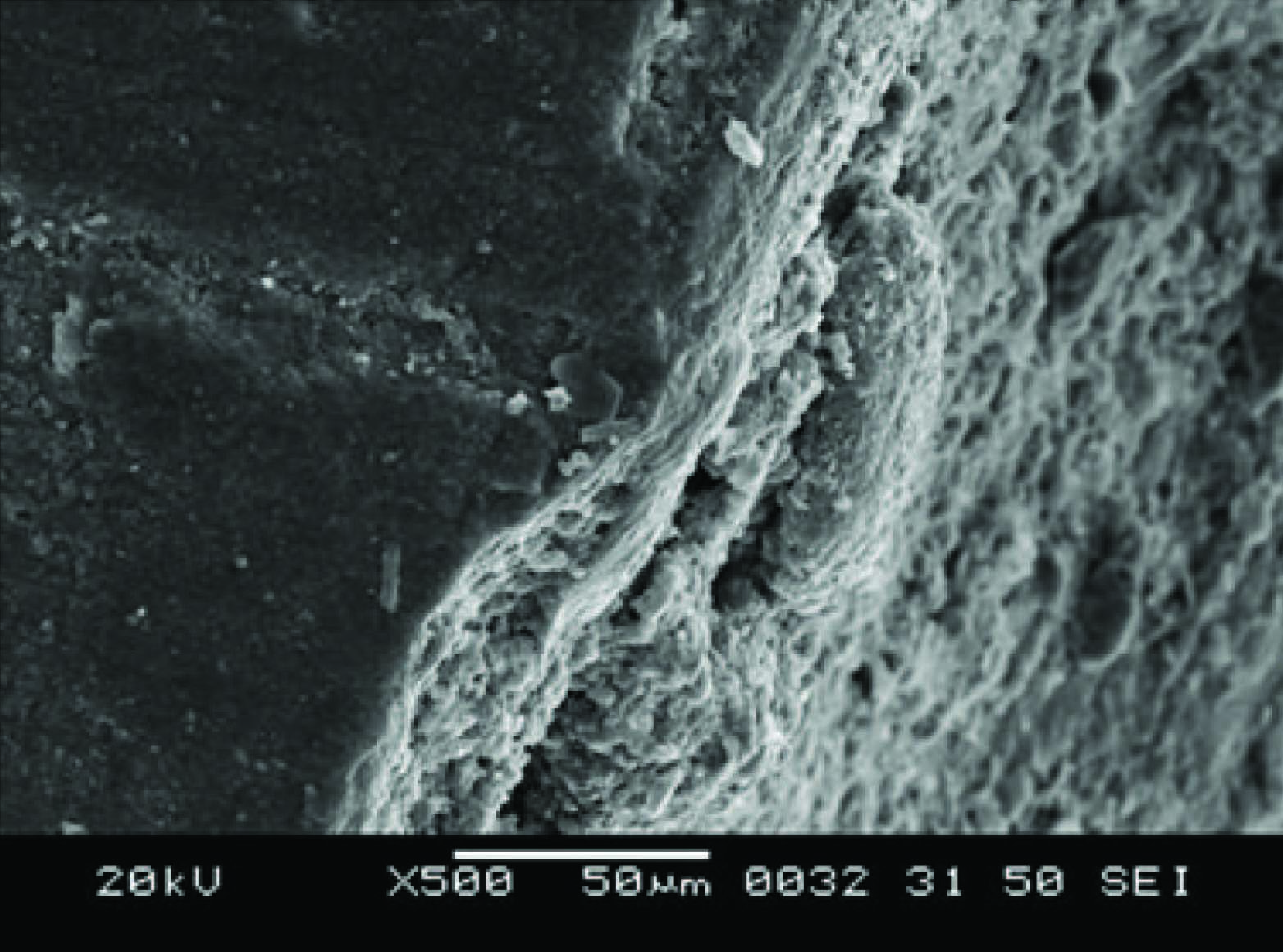
Adhesive fracture between porcelain and luting

Discussion
A durable bond between the tooth and the restoration depends on the chemical composition of the adhesive agent and luting agent, surface treatment of the laminates and the tooth [7,8]. In order to establish a successful adhesive bonding of the laminates fabricated with E-Max Press to tooth substance, proven methods for surface treatments were selected for this in vitro study [9]. Distilled water was used as a storage media in this study because the previous study carried out by ENAS H. Mobarak concluded that storage media/conditions had no effect on the shear bond strength of dentin to composite [10].
Stangel et al., [11] concluded that composite resin bonded to etched porcelain both with silane and silane with dentin adhesive produced high shear bond strengths. Acid etching with hydrofluoric acid, roughening the porcelain surface by means of grinding with a diamond bur, and the use of silane coupling agent alone and with combinations of these surface treatments were used in various in vitro studies [12–15]. Adhesive luting agents increase the fracture resistance of all-ceramic materials by penetrating into the flaws and irregularities of the restoration’s internal surface and inhibiting crack propagation [16–19]. The stresses at the interface of restorations are complex. However, they can be identified as primarily tensile or shear types of stresses, either created by forces working perpendicular or parallel to the tooth surface [20–22]. Therefore, in this study, shear bond tests were performed to test the adhesive bonding of the ceramic material with resin luting agents.
In the present study, the specimens were luted and kept in the specimen holder. The weight was kept constant so as to get uniform thickness of the luting agent. Bond strength evaluations were performed after 24 hours of water storage so as to imitate the clinical conditions. The highest value of shear bond strength was found for Group E i.e. Nexus NX3 followed by Group D, Group B and Group A. Group C showed the lowest value.
No significant differences were observed in failure mode or type of fracture frequencies among the test groups except Group C. This is in agreement with results of a recent study by Øzcan [23]. In the present study most of the failures in all groups of luting agents are adhesive in nature at the cement/veneer interface except in Group C i.e. VariolinkII where the cohesive failures in the the luting agent are more i.e., in 12 samples out of 16 [Table/Fig-5]. P Samimi [24] in his study concluded that the luting agent with lowest shear bond strength value exhibited greatest tendency for cohesive fractures in the luting agent. The values shown by Variolink II are in accordance with this conclusion. Higher shear bond strength and lower cohesive failure occurrence are found among the other groups luting agents used in this study. Nexus NX3 has exhibited the highest shear bond strength value. The scanning electron microscopic analysis of this group revealed that most of the failures are adhesive in nature [Table/Fig-5].
The statistical analysis of mode of fracture failure indicates that Variolink II is at more risk of fracture and RelyX ARC and Duolink are at the least risk. Nexus NX3 is slightly at the higher risk than these two groups of luting agent systems. But when we compare the shear bond strength values of all the luting agents used in this study, the highest mean shear bond strength value is exhibited by Nexus- NX3 (34.04 Mpa).When the multiple comparisons are done amongst the groups, Nexus NX3 is better as compared to other groups tested in this study.
Shear bond strength of the luting agent may be influenced by the composition. This has been claimed by the manufacturers. RelyX ARC, VriolinkII and Duolink are the monomer matrix composed of Bis-GMA and TEGDMA polymer. Panavia F2.0 contains 10, metha acryloxydecyl hydrogen phosphate. The highest value of Nexus NX3 can be correlated to its composition. The enhanced bond strength of this luting agent can be attributed to its proprietary amine free redox system. This is resistant to acidic monomers within air inhibited layer of the light cured adhesive agents.
The limitations of this study are that the complex nature of the masticatory forces in the oral cavity could not be produced by the Universal testing machine. The study was carried out on the extracted teeth.
Therefore ,within the limitation of this study , Nexus -NX3 is the best luting agent for luting of porcelain laminate veneers fabricated with IPS Empress II i.e. E.-Max Press (Lithium disilicate based ceramic material). Adhesive bonding characteristics of any luting agent is greatly influenced by the composition of that particular luting agent, when other parameters like the bonding surface area and the type of surface treatment of ceramic material are kept constant. However, further in vivo studies are necessary to confirm the efficacy of the resin luting agents used for luting porcelain laminates and role of its composition.
Conclusion
This in vitro study was carried out to comparatively evaluate the shear bond strength of duel cured resin luting agents used for the luting of porcelain laminate veneers. The difference in bond strength can be interpreted as the difference in fracture resistance of luting agents, to which shearing load was applied during the shear bond strength test. It is inferred from this study that the composition of the luting agent determines the adhesive characteristics in addition to surface treatment and bonding surface area.